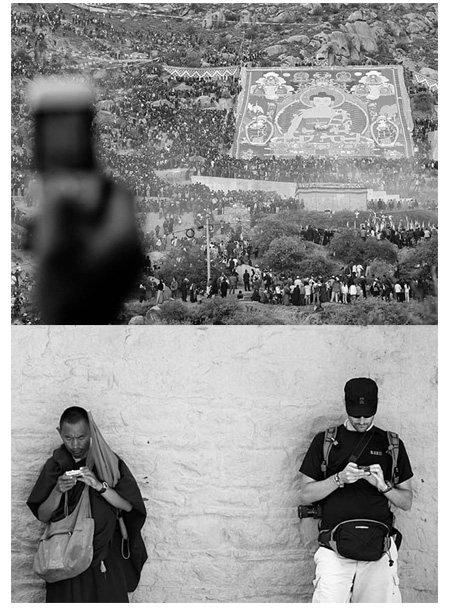
Top: Drepung Monastery shows devotees the huge Thangka. Thousands of tourists flash their cameras to record the precious moment. Above: A lama and a foreign tourist share the same wall of Norbulingka to lean against and check electronic equipment. Zhang Tao / China Daily
On the roof-top of the world, a celebration of faith and culture attracts both locals and visitors. In the face of advancing changes, Tibetans are still trying to hold on to their traditions. Qi Xiao reports from Lhasa.
Tibet draws the traveler like few tourist destinations do. Visitors take trains and planes up the mountainous heights to Lhasa with a reverence that borders on the religious, and makes a visit to Tibet come close to being a pilgrimage.
While the visitor skims the surface of both faith and culture during their brief stopovers, the average Tibetan takes these as part of daily life. To them, the various celebrations and ceremonies on their calendar are milestones for their families and children.
It is 5 am on August 10. The darkness of the night has not totally faded, but in the dim light of the street lamps, large crowds are already gathering as people pour out of their homes in Lhasa's crisp morning air.
A few miles away, thousands of devotees have already begun the steep ascent up the narrow, winding mountain paths leading up to Drepung Monastery.
Situated at the foot of the Mount Gambo Utse, 5 km away from Lhasa, Drepung is regarded as the most important monastery of Gelugpa (the "yellow hat" school) in Tibetan Buddhism.
Among the faithful is 39-year-old Yulo, who had got out of bed very early so she is assured of a vantage point for the ceremony that will come a couple of hours later.
But she is not one of the first on the hill. Some have already been there for a while, having set tents the previous day and waited through the night.
The cause of this enthusiasm is the eagerly anticipated ceremony called "Sunning of the Buddha".
As the sky lightens, the mountain begins to take shape. Tens of thousands have already congregated around the giant frame where a Thangka, or large tapestry of a religious icon, will be shown. There will be many perched around the most precarious slopes and boulders, just so to get a panoramic view of the Thangka.
Yulo's early efforts pay off and she secures a good position on the right of the giant frame, avoiding the crowds gathered at the foot of the hill.
Tibetan incense has long been burning and billowing smoke shrouds the mountain in a mystic mist.
Horns begin to blow and the crowd cheers as the huge Thangka with an image of Buddha is brought out from a low-lying building and carried up the ritual path by a hundred lamas and Tibetan devotees.
Many worshippers jostle along the route, trying to touch the blessed Thangka. Yulo waits excitedly while chanting prayers, and the two children with her seem also affected, more by the scene rather than the religious significance.
"There is a practical reason for the ceremony," explains Suonan Hangdan, the deputy curator of Tibetan Museum, "as the giant Thangka may suffer from mildew and damage if stored too long a time".
"The unfolding of the silk covering the Thangka is supposed to coincide with the first rays of sunshine so the blessings of the Buddha can shine upon everyone," he adds.
It is a little overcast and the sun does not break through the clouds until a couple of hours later, but the ceremony goes ahead at 8 am, according to plan.
Once the Thangka is set, tens of thousands of white Khatags (traditional white silk scarves) are immediately tossed onto it. More will pave its path as it progresses down the hill.
"I feel blessed," says Yulo, who manages to touch the Thangka and walk around it clock-wise as Tibetan Buddhism dictates. "You will be blessed and happy all year round if you touch it."
She has been attending the ceremony since she was 21, when her family moved from Qamdo county , more than 1,000 km away from Lhasa. She would have liked to attend the ceremony even earlier but she was living too far away. That is why she has brought her own children this time.
Her 11-year-old son Awang Linba, is a student at Lhasa Third Primary School, and this is his first experience at the Sunning ceremony. But, he looks more tired than enthusiastic.
"I feel blessed, too," his 12-year-old sister Renzeng Zhuoga says. For her, this is the second time and the little girl seems more energetic than her sleepy brother.
As the most important ritual that heralds the seven-day Shoton Festival, the Sunning of the Buddha normally draws hordes of worshippers and visitors.
"I am still overawed by their devotion," says Pete Winn, a visitor from Colorado who first came to the ceremony five years ago. "But it seems like five times as crowded this year."
The Shoton Festival is the most celebrated festival in the Tibetan calendar, and is rivaled only by the Tibetan New Year.
